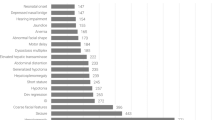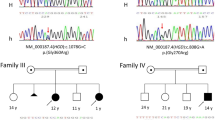Abstract
We used exome sequencing to identify the genetic basis of combined malonic and methylmalonic aciduria (CMAMMA). We sequenced the exome of an individual with CMAMMA and followed up with sequencing of eight additional affected individuals (cases). This included one individual who was identified and diagnosed by searching an exome database. We identify mutations in ACSF3, encoding a putative methylmalonyl-CoA and malonyl-CoA synthetase as a cause of CMAMMA. We also examined a canine model of CMAMMA, which showed pathogenic mutations in a predicted ACSF3 ortholog. ACSF3 mutant alleles occur with a minor allele frequency of 0.0058 in ∼1,000 control individuals, predicting a CMAMMA population incidence of ∼1:30,000. ACSF3 deficiency is the first human disorder identified as caused by mutations in a gene encoding a member of the acyl-CoA synthetase family, a diverse group of evolutionarily conserved proteins, and may emerge as one of the more common human metabolic disorders.
This is a preview of subscription content, access via your institution
Access options
Subscribe to this journal
Receive 12 print issues and online access
$209.00 per year
only $17.42 per issue
Buy this article
- Purchase on SpringerLink
- Instant access to full article PDF
Prices may be subject to local taxes which are calculated during checkout



Similar content being viewed by others
Accession codes
References
Gregg, A.R., Warman, A.W., Thorburn, D.R. & O'Brien, W.E. Combined malonic and methylmalonic aciduria with normal malonyl-coenzyme A decarboxylase activity: a case supporting multiple aetiologies. J. Inherit. Metab. Dis. 21, 382–390 (1998).
Podell, M. et al. Methylmalonic and malonic aciduria in a dog with progressive encephalomyelopathy. Metab. Brain Dis. 11, 239–247 (1996).
Biesecker, L.G. et al. The ClinSeq Project: piloting large-scale genome sequencing for research in genomic medicine. Genome Res. 19, 1665–1674 (2009).
Watkins, P.A., Maiguel, D., Jia, Z. & Pevsner, J. Evidence for 26 distinct acyl-coenzyme A synthetase genes in the human genome. J. Lipid Res. 48, 2736–2750 (2007).
Hiltunen, J.K., Chen, Z., Haapalainen, A.M., Wierenga, R.K. & Kastaniotis, A.J. Mitochondrial fatty acid synthesis–an adopted set of enzymes making a pathway of major importance for the cellular metabolism. Prog. Lipid Res. 49, 27–45 (2010).
An, J.H. & Kim, Y.S. A gene cluster encoding malonyl-CoA decarboxylase (MatA), malonyl-CoA synthetase (MatB) and a putative dicarboxylate carrier protein (MatC) in Rhizobium trifolii–cloning, sequencing, and expression of the enzymes in Escherichia coli. Eur. J. Biochem. 257, 395–402 (1998).
Koo, H.M. & Kim, Y.S. Identification of active-site residues in Bradyrhizobium japonicum malonyl-coenzyme A synthetase. Arch. Biochem. Biophys. 378, 167–174 (2000).
Black, P.N., Zhang, Q., Weimar, J.D. & DiRusso, C.C. Mutational analysis of a fatty acyl-coenzyme A synthetase signature motif identifies seven amino acid residues that modulate fatty acid substrate specificity. J. Biol. Chem. 272, 4896–4903 (1997).
Stuible, H., Buttner, D., Ehlting, J., Hahlbrock, K. & Kombrink, E. Mutational analysis of 4-coumarate:CoA ligase identifies functionally important amino acids and verifies its close relationship to other adenylate-forming enzymes. FEBS Lett. 467, 117–122 (2000).
Zou, Z., DiRusso, C.C., Ctrnacta, V. & Black, P.N. Fatty acid transport in Saccharomyces cerevisiae. Directed mutagenesis of FAT1 distinguishes the biochemical activities associated with Fat1p. J. Biol. Chem. 277, 31062–31071 (2002).
Sniderman, L.C. et al. Outcome of individuals with low-moderate methylmalonic aciduria detected through a neonatal screening program. J. Pediatr. 134, 675–680 (1999).
Teer, J.K. et al. Systematic comparison of three genomic enrichment methods for massively parallel DNA sequencing. Genome Res. 20, 1420–1431 (2010).
Chandler, R.J. et al. Propionyl-CoA and adenosylcobalamin metabolism in Caenorhabditis elegans: evidence for a role of methylmalonyl-CoA epimerase in intermediary metabolism. Mol. Genet. Metab. 89, 64–73 (2006).
Acknowledgements
We thank the subjects and families for participating, E. Ostrander for the gift of unrelated Labrador DNA samples, K.M. Gibson and R. Wander for performing the malonyl-CoA decarboxylase assay on fibroblasts from subjects 2 and 9, J. Teer for bioinformatics assistance, S. Suchy for subject referral, M. Podell and W. Gahl for helpful discussions, R. Fisher, I. Bernardini, A. Gropman, L. Hecht, F. Facio, C. Gitiaux, C. Ottolenghi, D. Rabier and G. Touati for laboratory assistance and clinical care, and M. Oglesbee and A. Genders for searching for dogs related to the affected Labrador retriever. J.L.S., J.J.J., I.M., R.J.C., N.C.-C., S.D.C., J.R.S., H.M.D., M.H., K.O., N.S.H., J.C.S., C.K., L.G.B. and C.P.V. were supported by the Intramural Research Program of the NHGRI, NIH. M.D.G. was supported by NIA K23 AG021989 and R01-AG031189.
Author information
Authors and Affiliations
Consortia
Contributions
J.C.S. and L.G.B. developed the exome sequencing protocol. J.L.S., I.M., J.C.S., L.G.B. and C.P.V. designed the clinical research studies. The NIH Intramural Sequencing Center Group (N.I.S.C.G.) performed exome sequencing. J.J.J., J.L.S., I.M., R.J.C., L.G.B. and C.P.V. performed bioinformatic analyses. J.J.J. and C.K. performed mutational analysis and genotyping. R.J.C., N.C.-C., S.D.C. and J.R.S. performed cell culture studies and protein blot analyses. R.J.C. created viral vectors and performed cellular complementation studies. J.L.S., M.H. and H.M.D. performed immunofluorescence experiments. J.L.S., J.R.S. and I.M. performed enzymatic assays. J.L.S., I.M., N.S.H., K.O., J.C.S., B.A.B., S.A.B., P.M.J., N.L.C., P.d.L., V.V., M.D.G., W.L.N., L.G.B. and C.P.V. contributed to clinical evaluations and the delineation of the subject phenotypes. D.K.G. performed organic acid measurements. J.L.S., J.J.J., L.G.B. and C.P.V. prepared the manuscript. L.G.B. and C.P.V. conceived of and supervised the study.
Corresponding author
Ethics declarations
Competing interests
The authors declare no competing financial interests.
Additional information
NIH Intramural Sequencing Center Group
Supplementary information
Supplementary Text and Figures
Supplementary Figures 1–4 and Supplementary Tables 1–3. (PDF 2074 kb)
Rights and permissions
About this article
Cite this article
Sloan, J., Johnston, J., Manoli, I. et al. Exome sequencing identifies ACSF3 as a cause of combined malonic and methylmalonic aciduria. Nat Genet 43, 883–886 (2011). https://doi.org/10.1038/ng.908
Received:
Accepted:
Published:
Issue Date:
DOI: https://doi.org/10.1038/ng.908



